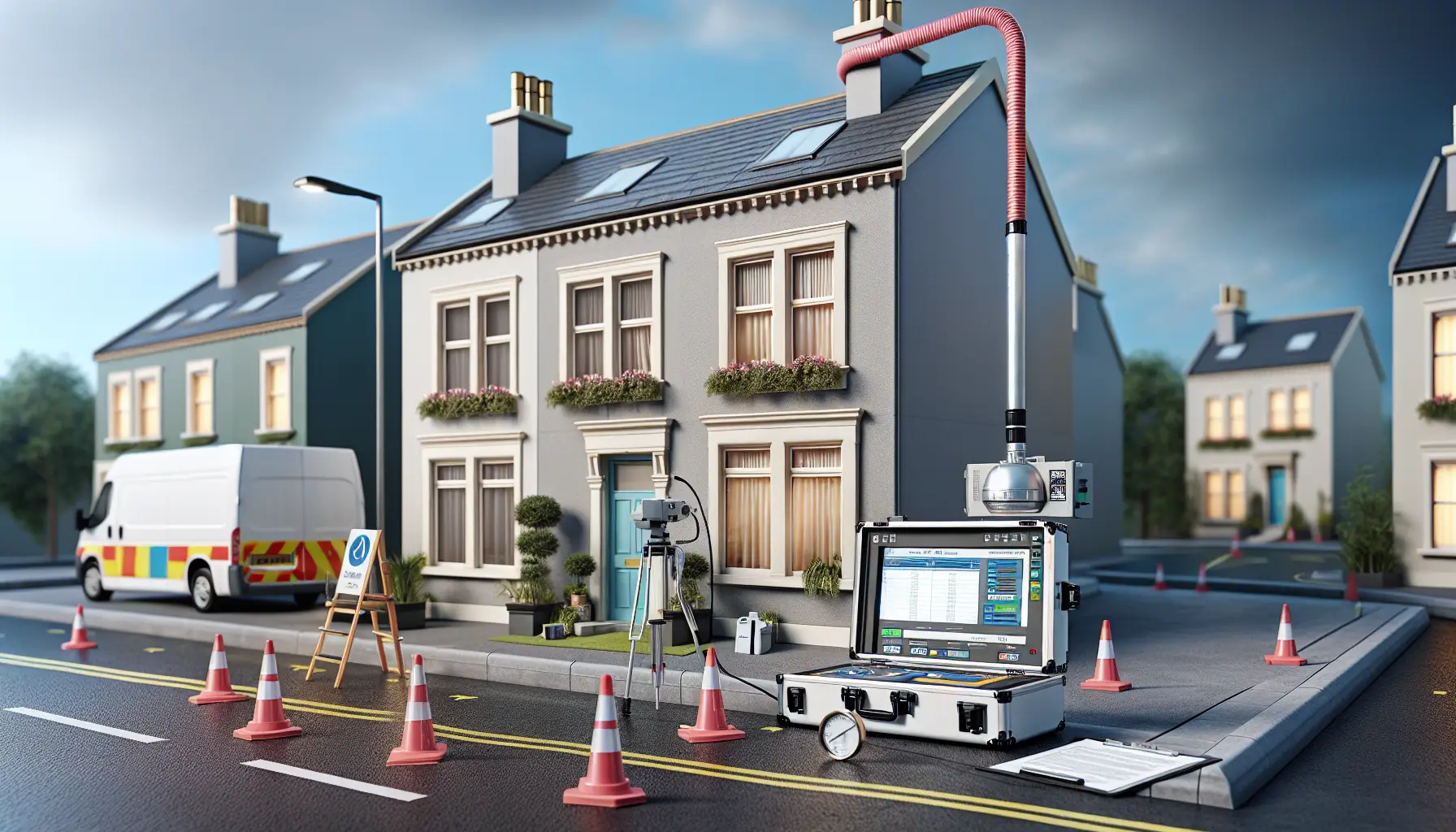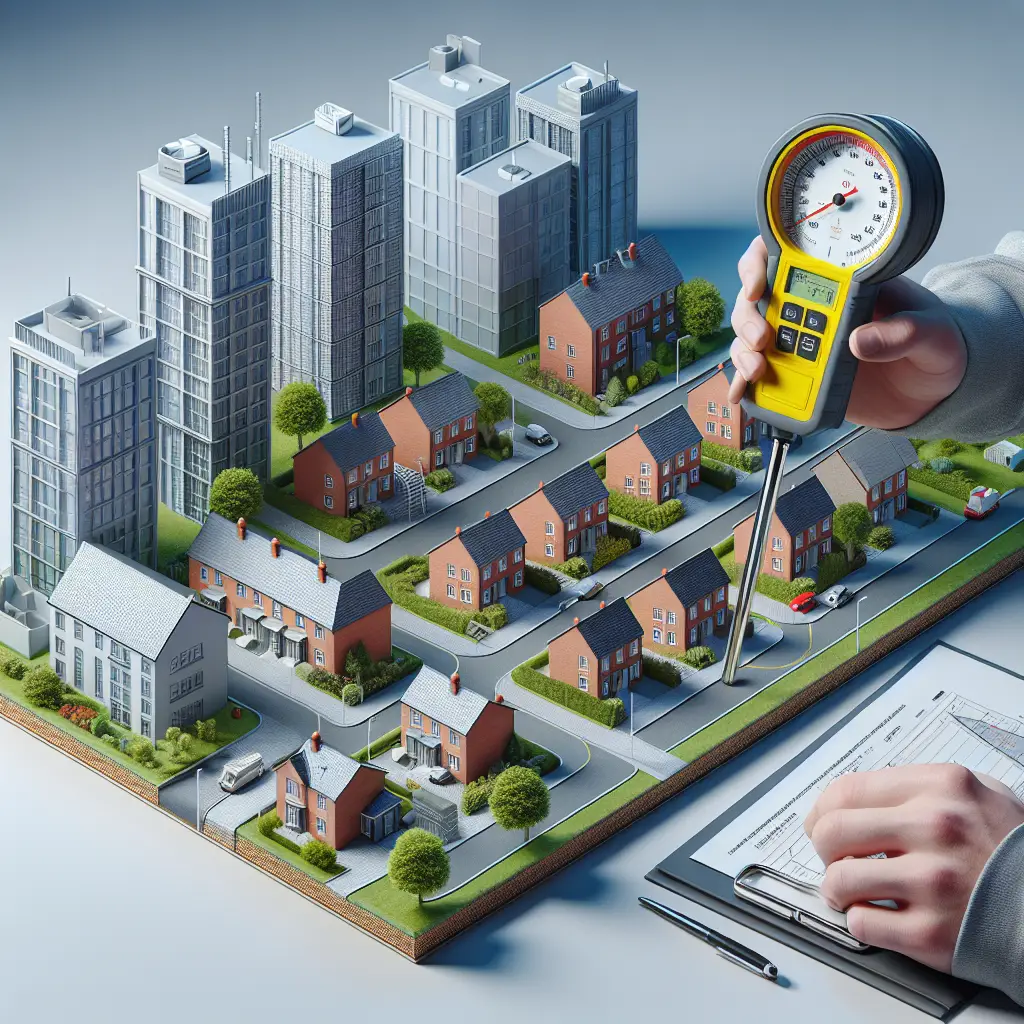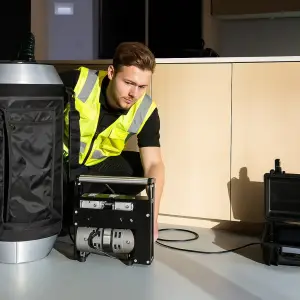What is Airtightness Testing and Why Does It Matter?
Airtightness testing, sometimes called air leakage testing or air pressure testing, is a way to check how much air escapes from a building through gaps or cracks. It’s a requirement for new homes and many commercial buildings across the UK. The test helps show whether a building can keep heat inside or if warm air will sneak out through tiny gaps.
We at Ratio Seven offer professional airtightness testing UK-wide, making it easy for builders, developers and homeowners to meet strict building regulation standards. Whether the property is still under construction or already built, we carry out accurate and reliable tests to see if everything meets current Part L regulations.
Not only does leakage testing help with building compliance, but it can also save a lot of money on energy bills and reduce the carbon footprint. If a home or office lets heat escape, then the heating system has to work harder, using more energy and costing more money.
How We Test for Air Leakage
Our process at Ratio Seven for airtightness testing is very straightforward. We use a blower door fan that fits onto an external door opening in the building. Once it’s sealed, the fan either blows air into the building or draws it out. This creates pressure that helps us measure how much outside air sneaks in through cracks around windows, doors and other gaps.
We take multiple pressure readings to make sure we get accurate results. With our high-quality equipment and experience, we can easily detect tiny leaks and highlight areas that need attention. Everything follows British Standards (ATTMA TSL1 & TSL2), so you’ll know you’re getting full compliance with regulatory standards.
If you’re looking for quality airtightness testing in the UK, we’re happy to help with friendly advice and stress-free testing.
Domestic Testing for Homes and Self-Build Projects
Homeowners or self-builders often wonder why airtightness testing matters. The answer is simple: it leads to better comfort and better performance for your property. A home that passes the airtightness test will be warmer in winter, cooler in summer, and cheaper to run.
At Ratio Seven, we’re often called in to test homes ranging from flats to large detached properties. Each one has its unique design, so tailored testing is essential. We work with builders at different stages, from pre-test warmups to final assessments before handing the keys over to the new owners. Even if your property has already been built, our team can still provide pre-test reports and guidance to improve your results.
For people building their first home, we know the process can feel overwhelming. That’s why we focus on giving clear, simple advice and showing you exactly what areas might be losing heated air. You’ll find detailed support on our air testing FAQs page, which answers the most common questions our clients ask.
Commercial Airtightness Testing for Buildings Big and Small
Larger buildings like retail units, offices, hospitals, or schools also need airtightness testing. The rules for commercial air testing are slightly different from those for houses, but the goal stays the same: to reduce wasted energy and meet Building Regulations.
Whether the building is a new warehouse or a multi-storey office block, we bring the same level of dedication. Our trained testers know how to work around awkward layouts or construction stages, and we keep you updated throughout the entire process. We’ll even liaise with your site manager or architect if needed.
Many commercial clients choose Ratio Seven for regular testing on multiple sites, knowing that they’ll get honest results and helpful reports every time. After we complete the test, we’ll give you everything you need to ensure compliance, including official certificates for the Building Control officer.
When is Airtightness Testing Needed?
If you’re building a new house in England or Wales, most homes must pass an air leakage test before completion. In Scotland, testing is required for all new dwellings. Some conversions might also need a test, depending on the scope of the work.
Commercial buildings over a certain size (500m² floor area) also need air pressure testing, unless they fall under special exemptions. Whether you’re building one house or many units in a development, we can help make sure everything goes smoothly.
Waiting until the last minute to arrange testing can lead to failed results or delays in getting handover paperwork, so we advise getting in touch as early as possible.
What Happens if You Fail the Airtightness Test?
If your building doesn’t pass the first time, don’t panic. We’ll walk you through what went wrong and, more importantly, how to fix it. Our reports show clear photos, pressure readings, and easy-to-follow advice. Sometimes, it’s something small like silicone missing around a window or a poorly sealed loft hatch.
In many cases, we’re able to retest on the same day, once the problem has been resolved. The key is to keep communication open, stay on site if possible, and let us help you find a solution. That’s what makes our sealing advice so helpful. By working together, a pass is just around the corner.
Even if you’re not sure whether your building is ready for testing, get in touch, and we can let you know the next steps.

Questions We Hear All the Time
We understand that this kind of testing may feel a bit confusing, especially for people who don’t work in construction.
That’s why we’ve created a handy FAQ page to explain things like:
- What is the ideal air leakage score?
- What happens if there are trickle vents?
- How long does the test take?
- Can you test during rain or wind?
- What if the house isn’t finished?
These are real questions asked by real customers, and we answer every one in a way that’s easy to understand. If your question isn’t covered, you can call or email us directly, and we’ll be happy to help.
Why Choose Ratio Seven?
We love what we do, and we bring that energy into every test we complete. At Ratio Seven, we’ve helped hundreds of builders, developers and homeowners hit the numbers they need.
Here’s what makes us stand out:
- Clear pricing with no silly extras
- Nationwide coverage with fast response times
- Fully ATTMA-accredited testers
- Helpful pre-test advice and air sealing guides
- Post-test reports are delivered quickly
- Friendly customer service every step of the way
Over the years, our small team has become a trusted partner across the housebuilding and commercial sectors. We’re proud of the feedback we receive and always strive to make every visit smooth and supportive.
Want to know more? Check out our main website at Ratio Seven where you’ll find case studies, support documents and background on the people behind your test.
Wrap-Up and Next Steps
Airtightness testing isn’t just about ticking a box for Building Control. It’s about making buildings that are warmer, quieter, and more affordable over time. If you’ve got a self-build, a big new office project, or just need help sealing a few trouble spots, we’re here for you.
Start your journey to passing the test with the team at Ratio Seven. Book a consultation or read more from our air testing FAQs. For commercial clients, be sure to review our full range of support for commercial air testing.
Get in touch today and let’s get your building over the finish line.




